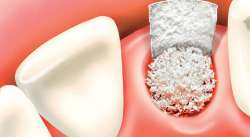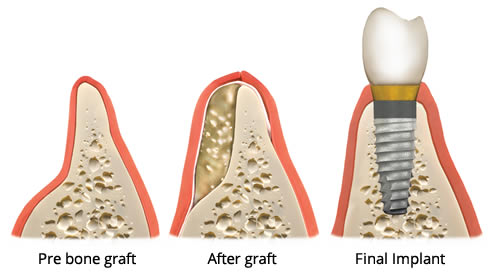Dental Implant Bone Grafts

What are Dental Implant Bone Grafts?
Dental implant bone grafting is a surgical procedure performed before the placement of dental implants to replace missing bone with a bone graft and help the body regenerate new bone in jaw areas with severe bone loss . Bone grafts help to create new bone with sufficient mass and strength for the successful osseointegration of the implants.
In this Article:
When/Why you need Dental Bone Grafting?
A dental implant bone graft is necessary when the jawbone is missing the adequate width/height or doesn't have sufficient strength and stability to support the placement of one or more dental implants.
The success of a dental implant procedure depends significantly on the existence of healthy jaw bone around it to allow proper bonding to the jaw. Lack of sufficient bone may lead to implant failure.
Many patients can't replace missing teeth with dental implants due to the poor condition of the bone in their jaws, so their only alternative are conventional bridges or dentures. Bone grafting can restore the lost bone and allow them to have new completely functional teeth with dental implants.
In general, you may need dental bone grafting in case of:
- Missing teeth bone loss - When a tooth is lost, the body thinks that the bone around it is no longer needed and starts a resorption process to recover the bone minerals that leads to bone loss.
- Periodontal disease bone loss - Infections of the periodontium trigger a response from the body's immune system that can cause severe loss of jaw bone structure.
- Other causes of bone loss - Injury, trauma, developmental defects, or the removal of cysts and tumors may also cause bone defects that require bone grafting.
What is a Bone Graft? How it works?

A bone graft is bone tissue (organic or synthetic) that is placed in jaw areas with missing bone (see also Types of Bone Grafts). During the body's normal operation, specialized cells in the blood continually remove damaged cells from the bone tissues and replace them with new, healthy cells. Bone grafting takes advantage of this process, by providing a framework of graft material in the areas of missing bone into which these cells can enter and start creating new bone.
How long after bone grafting can I get my dental implant?
The bone graft will take about 3 to 12 months until the bone regeneration process has completed and the dental implants can be placed. The time required depends on the amount of the grafted bone, the type of dental bone graft and if any bone growth accelerating factors are used.
Average Cost of Dental Implant Bone Grafting
Patients with severe jaw bone loss should be prepared to add the dental bone graft cost to the overall cost of the dental implant treatment. There is also a cost in terms of time, as it will add 3 to 6 months to the length of the overall treatment.
The average cost of dental implant bone graft can range from $250 to $900 for a single surgical area depending on the amount of bone graft needed, the type of bone graft and the difficulty of each case.
- In case of autogenous grafts taken from the hip bone, the cost of bone graft can raise well over $2,500 due to the additional costs for hospitalization, medications, orthopedic surgeon and anesthesiologist.
- Allografts and xenografts usually cost less due to the simpler surgical procedure.
- The use of Growth Factor Enhanced Grafts in order to accelerate the bone formation can reduce the time of treatment but will further increase the cost of the bone graft procedure.
Considering the high success rate of the procedure, if bone grafting has been recommended by your dentist, you should not try to save the bone graft cost risking a dental implant failure.
Are Bone Grafts covered by Dental Insurance?
Before starting the treatment, you should check with your dental insurance if dental bone grafts costs are covered and if any restrictions apply. Dental implants are not covered by dental insurance, but you may get some insurance coverage for some parts of the treatment as the bone grafting.
In cases when there is extensive bone loss, a medical insurance will cover the bone grafting cost, if the treatment is proved to be medically necessary. If the bone loss was caused by accident, injury or medical conditions other than dental health issues, the cost of bone grafts is usually covered by general health insurance policies. If the patients ability to eat is seriously affected and it can not be restored with other options such as dentures, dental or/and medical insurance may also provide coverage.
Types of Dental Bone Grafts
Bone graft materials are classified based on the source of the bone used in the procedure as:
- Autografts. Autografts are bone grafts taken from the patient's own body. Autografts give the best results amongst all types of dental implant bone grafts but their disadvantage is that a second surgery is needed where the bone graft will be taken from.
- Allografts. Allografts are human bone grafts taken from another person, provided by bone banks.
- Xenografts. Xenografts are bone grafts made from sterilized non organic materials of animal bone, usually from bovine (cow) or porcine (pig) origin.
- Alloplasts. Alloplasts make use of synthetic materials for bone formation. Alloplastic bone grafting is believed to be less effective than autogenous bone grafting but it has much less risk for infections.
- Growth Factor Enhanced Grafts. GF Enhanced Grafts are produced using recombinant DNA technology. They accelerate considerably the bone formation process but they are more expensive.
Types of Bone Grafting procedures
The procedure, also known as bone augmentation, can be used to replace missing bone in different areas of the mouth, so that implants can be placed:
- Extraction site Bone Graft - The most common are bone grafts in the socket of the extracted or lost tooth, where the implant will be placed and the jawbone must have sufficient quality and quantity.
- Sinus Lift - Sinus lift bone grafts aka sinus augmentation are sometimes required for placing upper jaw implants, when there is not enough bone depth of jaw bone below the sinus cavity.
- Ridge Augmentation - Bone grafts are used to increase the bone ridge width and/or height when after tooth extraction the ridge has become too narrow not allowing the placement of dental implants.
Timing of the dental implant bone graft surgery
Bone grafting can be used to correct existing bone loss problems or to prevent bone loss in preparation of dental implant placement. The time that the bone graft procedure is performed depends on the individual's treatment plan prepared by the implant dentist. Bone grafting can take place:
- Before the Implant Placement - if x-rays or CT-scans have shown that there is not enough jawbone, the dentist will plan first the bone grafting procedure. The placement of dental implants has to be delayed for several months until there is adequate bone build up.
- During the Implant Placement - Sometimes, a jaw bone problem is revealed only when the bone is exposed during the surgery. If the problem is not severe, the dentist may perform a bone graft and place the implant in the same surgical phase, or postpone the placement for some weeks/months.
- After Tooth Extraction (Preventive bone grafts) - A dentist may perform a bone graft immediately after a tooth extraction to preserve existing bone tissue (Ridge Reservation) and stimulate new bone creation in the socket to provide a suitable environment for placing a dental implant in the future.
The Dental Implant Bone Grafting Surgery
The procedure described below refers to a typical autogenous bone graft needed for the placement of one dental implant. The bone graft is typically taken from the patients chin. In this case the procedure can be performed in the dental office without requiring hospitalization.
- Both surgical areas (the area to receive the graft -recipient site- and the area from where it will be extracted -donor site-) are numbed with local anaesthesia.
- An incision is first made at the implantation area to expose the bone and determine precisely how much bone is needed. Any sign of infection or inflammation is a definite stop signal for bone grafting.
- A second incision is made below the lower front teeth to expose the chin jaw bone.
- A suitable block of bone is removed from that area.
- The bone graft is placed at the recipient site and secured with titanium screws if needed.
- Sometimes the bone graft is mixed with some other bone-graft material and/or bone growth factors. Some bleeding may also be induced because blood provides cells that help the bone heal.
- The dentist may also place allograft material at the donor site to help repairing the chin bone.
- Both surgical sites are covered with barrier membranes to protect the area and help the guided bone regeneration process.
When bone grafts are placed in combination with biocompatible barrier membranes that keep out gum tissue and enhance the bone growth, the procedure is called Guided Bone Regeneration (GBR).
Aftercare - Instructions after dental bone graft
The failure rate of bone grafting is very low if the post operative instructions are followed. Proper aftercare is important in order to minimize possible complications. If the bone graft fails, you will have to repeat the dental bone graft procedure and delay the placement of dental implants.
- After the bone graft procedure, the dentist will prescribe antibiotics, pain medication and an antibacterial mouthwash. Some pain is expected for about a week after the procedure.
- Avoid putting pressure on the bone graft area while it heals.
- A soft diet is recommended for some days. Hot foods should also be avoided.
- Edentulous patients may find it difficult to wear their denture until the area heals.
- You must maintain good oral hygiene, but avoid disturbing the bone graft area.
What's the success rate of dental implant bone grafts?
The success rate is at least 90 - 95% for dental implant related bone grafts. Treatments performed by an experienced dentist and with proper aftercare have a failure rate of les than 5%. The factors that can increase the bone graft failure rate are similar to those causing implant failures.
Indications of a failed dental implant bone graft include lesions exposing the graft, loss of large amount of bone graft material, graft mobility or signs of infection such as pus and drainage in the bone graft area. If bone grafting fails, any remaining graft material should be removed and the area should be cleaned and left to heal for some time. When healed, a second bone graft can be placed.
next page -> What is Sinus Lift (Sinus Augmentation)?



